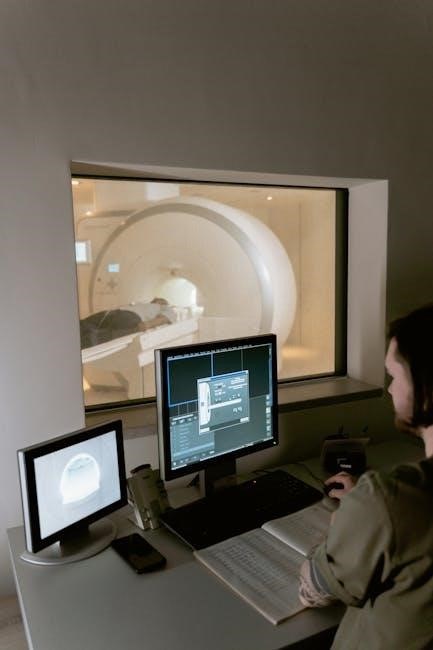The DISC Personality Test is a widely used assessment tool designed to evaluate individual behavior, communication styles, and work preferences, focusing on four core personality types.
1.1 Overview of the DISC Personality Test
The DISC Personality Test is a behavioral assessment tool that evaluates individual styles based on four core dimensions: Dominance, Influence, Steadiness, and Conscientiousness. It provides insights into how people interact, make decisions, and adapt to their environments. By analyzing typical behaviors, the test helps identify strengths, communication preferences, and workplace tendencies. The assessment is quick, requiring only 8-10 minutes, and offers practical insights for personal and professional growth. It is widely used for improving teamwork, leadership, and self-awareness, making it a valuable resource for both individuals and organizations.
1.2 Importance of Understanding Personality Types
Understanding personality types through the DISC assessment is crucial for enhancing communication, teamwork, and leadership. By recognizing individual strengths and areas for growth, individuals can adapt their behaviors to foster collaboration and reduce conflicts. This insight helps in tailoring approaches to meet others’ needs, improving workplace dynamics and personal relationships. It also aids in self-awareness, enabling individuals to leverage their strengths and address weaknesses. Ultimately, understanding DISC personality types promotes empathy, effective decision-making, and a more harmonious work environment, making it a valuable tool for personal and professional development.
1.3 Brief History and Development of the DISC Model
The DISC model was first introduced by psychologist William Moulton Marston in his 1928 book Emotions of Normal People, outlining four primary behavioral traits: Dominance, Influence, Steadiness, and Compliance. Over the years, researchers like John Cleaver refined the theory, transforming it into a practical assessment tool. The modern DISC test was developed to evaluate individual behavioral styles, focusing on observable actions rather than underlying motivations. Its evolution has led to widespread use in workplace communication, leadership development, and team-building, making it a cornerstone of personality assessments in both personal and professional contexts.

The Four DISC Personality Types
The DISC model categorizes personalities into four types: Dominance (D), Influence (I), Steadiness (S), and Conscientiousness (C), each representing distinct behavioral traits and tendencies in individuals.
2.1 Dominance (D) ౼ Decisive and Strong-Willed
Individuals with a Dominance (D) personality type are characterized by their decisiveness, assertiveness, and strong will. They are natural leaders who thrive on control and achieving results. People with a high D score are direct, confident, and comfortable taking charge, often prioritizing efficiency and action over collaboration. While their strength lies in making quick decisions, they may struggle with patience and delegating tasks. This trait-driven approach makes them well-suited for leadership roles but can sometimes lead to challenges in team dynamics if not balanced with empathy and adaptability.
- Key traits: Assertive, results-oriented, and decisive.
- Challenges: May struggle with patience and delegating tasks.
2.2 Influence (I) ౼ Outgoing and Persuasive
Individuals with an Influence (I) personality type are outgoing, sociable, and excel at persuading others. They thrive in environments where they can interact with people, share ideas, and inspire action. People with a high I score are naturally optimistic, enthusiastic, and enjoy being the center of attention. Their strength lies in building relationships and motivating others, but they may struggle with focusing on details or making tough decisions. This trait makes them ideal for roles requiring strong communication and teamwork, though they may need to balance their talkative nature with active listening.
- Key traits: Sociable, persuasive, and enthusiastic.
- Challenges: May be overly talkative or avoid conflict.
2.3 Steadiness (S) ─ Patient and Reliable
Individuals with a Steadiness (S) personality type are known for their patience, reliability, and consistency. They value stability and loyalty, often preferring predictable environments where they can provide support and maintain harmony. People with a high S score are good listeners, calm under pressure, and excel at building trust. Their strength lies in their ability to remain steady and dependable, even in challenging situations. However, they may resist change and hesitate to take initiative, preferring to focus on quality and thoroughness over speed and innovation.
- Key traits: Patient, reliable, and consistent.
- Strengths: Loyalty, stability, and dependability.
- Challenges: Resistance to change, hesitation in leadership roles.
2.4 Conscientiousness (C) ౼ Analytical and Meticulous
Individuals with a high Conscientiousness (C) score are analytical, meticulous, and detail-oriented. They prioritize accuracy, organization, and adherence to standards, often excelling in roles requiring precision and quality control. People with a C personality type tend to be reserved, thoughtful, and systematic in their approach, preferring to plan thoroughly before acting. While they are highly reliable and ensure tasks are completed to a high standard, they may struggle with flexibility and can sometimes be overly critical or perfectionistic, which may slow decision-making processes.
- Key traits: Analytical, organized, and detail-focused.
- Strengths: Ensures accuracy, maintains high standards, and is systematic.
- Challenges: May overanalyze, resist spontaneity, and be overly critical.

How the DISC Test Works
The DISC test evaluates individual behavior across four styles: Dominance, Influence, Steadiness, and Conscientiousness. Participants answer questions about typical behavior, yielding a personalized profile for insights into workplace communication and behavior.
3.1 Understanding the DISC Assessment Process
The DISC assessment process involves a structured questionnaire that evaluates an individual’s behavioral preferences across four dimensions: Dominance, Influence, Steadiness, and Conscientiousness. Participants respond to questions about their typical behavior, focusing on how they act in various situations. The test is designed to be quick, typically taking 8-10 minutes, and requires honest, gut-level responses for accuracy. Scores are calculated based on the intensity of traits within each dimension, resulting in a personalized profile. This profile provides insights into communication styles, decision-making tendencies, and workplace interactions, helping individuals and teams improve collaboration and productivity. The process emphasizes practical applications of the results.
3.2 How to Take the DISC Personality Test
Taking the DISC Personality Test is straightforward and typically takes 8-10 minutes. Participants answer a series of questions about their typical behavior in various situations. Responses are recorded on a scoring sheet, with options ranging from most to least descriptive of their actions. Honesty is crucial for accurate results. After completing the test, scores are tallied for each DISC dimension (Dominance, Influence, Steadiness, Conscientiousness), providing a personalized profile. This profile highlights strengths, communication styles, and behavioral tendencies, offering insights for personal and professional development.
3.3 Interpreting Your DISC Profile Results
Interpreting your DISC profile involves understanding your scores across the four dimensions: Dominance, Influence, Steadiness, and Conscientiousness. The results are often presented in a graph, showing your behavioral tendencies and preferences. Each dimension is scored on a scale, indicating your strengths and areas for improvement. The profile highlights your communication style, decision-making approaches, and workplace habits. By analyzing these insights, you can identify how your personality influences your interactions and performance. This interpretation is key to leveraging the test for personal growth, improved relationships, and professional success, providing a clear roadmap for self-awareness and development.

Practical Applications of the DISC Test
Enhancing workplace communication and teamwork, the DISC test aids leaders in understanding team dynamics, improving collaboration, and optimizing performance through tailored strategies.
4.1 Using DISC in Workplace Communication
The DISC personality test significantly enhances workplace communication by helping individuals understand and adapt to different behavioral styles. By identifying Dominance, Influence, Steadiness, and Conscientiousness traits, employees can tailor their interactions to align with colleagues’ preferences, fostering clearer and more effective communication. This leads to improved collaboration, reduced misunderstandings, and a more respectful work environment. Understanding DISC profiles allows teams to address potential conflicts proactively and leverage each member’s strengths, creating a harmonious and productive workplace culture. This approach ensures that communication strategies are personalized and impactful, driving better outcomes for both individuals and organizations.
4.2 Role of DISC in Team Building and Leadership
The DISC personality test plays a crucial role in team building and leadership by providing insights into individual behavioral styles. Leaders can use DISC profiles to understand team dynamics, identify strengths, and address areas for improvement. By recognizing the Dominance, Influence, Steadiness, and Conscientiousness traits of team members, leaders can assign roles that align with their natural tendencies, fostering a balanced and cohesive team. DISC also enhances leadership effectiveness by promoting mutual respect, encouraging collaboration, and helping leaders adapt their communication style to inspire and motivate diverse team members effectively. This approach strengthens overall team performance and harmony.
4.3 Applying DISC Insights in Recruitment and Hiring
The DISC personality test is a valuable tool in recruitment and hiring, helping organizations identify candidates whose behavioral styles align with specific roles. By assessing Dominance, Influence, Steadiness, and Conscientiousness traits, employers can gauge how well a candidate fits the job requirements and team culture. DISC insights enable HR professionals to make informed decisions, reducing turnover and improving team dynamics. This approach ensures that candidates are placed in roles where they can leverage their strengths, fostering productivity and satisfaction. It also aids in creating well-rounded teams with diverse skill sets and perspectives.

Benefits of the DISC Personality Assessment
The DISC assessment enhances self-awareness, improves communication, and strengthens teamwork. It helps individuals identify strengths, address weaknesses, and align behaviors with personal and professional goals effectively.
5.1 Improving Self-Awareness and Personal Growth
The DISC personality test enhances self-awareness by providing insights into individual behavioral tendencies and communication styles. By identifying strengths and areas for growth, it empowers personal development. Users gain clarity on their decision-making processes, problem-solving approaches, and interpersonal interactions. This self-awareness fosters personal growth by encouraging individuals to adapt behaviors that align with their goals and values. The test also highlights how to leverage natural traits effectively, promoting emotional intelligence and self-improvement in both personal and professional contexts.
5.2 Enhancing Communication Skills
The DISC personality test helps individuals understand their communication styles and adapt to others, fostering effective interactions. By identifying personal traits like assertiveness or patience, users can tailor their approach to match diverse personalities. This insight enables clearer expression of ideas, active listening, and empathy. Improved communication reduces misunderstandings and strengthens relationships in both professional and personal settings. The test empowers individuals to navigate conversations confidently, ensuring their message is conveyed effectively and respectfully, leading to better collaboration and teamwork.
5.3 Strengthening Team Collaboration and Productivity
The DISC personality test enhances team collaboration by helping members understand each other’s behaviors and communication styles. This understanding fosters mutual respect and reduces conflicts. Teams can align roles with individual strengths, improving productivity and workflow. By addressing diverse work styles, the DISC model encourages active participation and creates a cohesive environment. This leads to better decision-making and problem-solving, ultimately strengthening team performance and achieving shared goals more effectively. The insights gained promote a culture of collaboration, driving overall success and morale within the organization.
How to Choose the Right DISC Test
Evaluate the test’s accuracy, reliability, and alignment with your needs. Consider validity, user-friendliness, and whether it offers detailed insights. Compare free and paid options to find the best fit.
6.1 Evaluating the Accuracy and Reliability of DISC Tests
Evaluating the accuracy and reliability of DISC tests involves assessing their scientific validation, research backing, and consistency in results. Reputable tests, like those published by Wiley, are supported by over 40 years of research and refinement. Look for assessments with high validation rates, such as the 90% validation reported in studies. Ensure the test measures observable behaviors rather than hidden traits, providing clear and actionable insights. Consistency in results over time and across similar situations is also crucial for reliability. Choose tests with transparent methodologies and practical applications to ensure they meet your needs effectively.
6.2 Factors to Consider When Selecting a DISC Assessment
When selecting a DISC assessment, consider the publisher’s reputation, scientific backing, and validation. Reputable tests, like those from Wiley, are supported by decades of research. Ensure the assessment measures observable behaviors, providing clear, actionable insights. Look for user-friendly formats, such as PDF, and clear reporting. Assessments should avoid bias, recognizing that each DISC style has unique strengths. Verify the test’s ability to distinguish between primary and secondary traits. Finally, evaluate its practical applications for personal or professional use, ensuring it aligns with your goals for self-awareness, communication, or team development.
6.3 Free vs. Paid DISC Personality Tests
Free DISC tests offer a quick insight into personality types, making them accessible for basic self-awareness. They often lack depth and customization compared to paid versions. Paid tests, such as those from Wiley, provide detailed, research-backed profiles with actionable insights. They are ideal for professional development and team-building. While free tests are suitable for casual use, paid assessments ensure accuracy and comprehensive reporting. Consider your goals: free tests for simple insights, paid for in-depth analysis and practical applications.

Common Mistakes to Avoid When Taking the DISC Test
Avoid overgeneralizing results, as most individuals exhibit mixed traits. Ensure honest responses, as the test measures typical behavior, not idealized selves. Misinterpretation can lead to inaccurate insights.
7.1 Ensuring Honest and Authentic Responses
Honesty is crucial when taking the DISC test, as it measures typical behavior rather than idealized selves. Respondents should avoid overthinking and instead go with their gut feelings. Answering based on how you truly act, not how you aspire to be, ensures accurate results. Dishonest or skewed responses can lead to misleading profiles, undermining the test’s effectiveness. Authentic answers allow for a genuine understanding of strengths, weaknesses, and behavioral tendencies, making the assessment more valuable for personal and professional growth.
7.2 Avoiding Overgeneralization of Results
Overgeneralizing DISC results can lead to misinterpretation, as individuals often exhibit traits from multiple styles. While the test identifies dominant tendencies, it’s essential to recognize that most people are a blend of types rather than fitting neatly into one category. Overgeneralization can result in stereotyping or oversimplification, limiting the test’s effectiveness. To avoid this, focus on understanding the nuances of your profile and how different traits manifest in various contexts. This approach ensures a more accurate and practical application of the DISC insights for personal or professional development.
7.3 Misinterpretation of DISC Profiles
Misinterpreting DISC profiles is a common pitfall, often due to misunderstanding the context or nuances of the results. Many assume their DISC style is fixed, but it actually reflects behavioral preferences in specific situations. Overly rigid interpretations can lead to limiting self-perceptions or misjudging others. To avoid this, consider the context in which behaviors are observed and recognize that styles can adapt. A balanced approach ensures that DISC insights are used to enhance understanding rather than constrain potential. Proper interpretation fosters personal growth and effective communication, aligning with the tool’s intended purpose.
Comparing DISC with Other Personality Assessments
The DISC model is often compared to MBTI and the Big Five, but focuses on observable behaviors rather than personality types, making it practical for workplace applications.
8.1 DISC vs. MBTI (Myers-Briggs Type Indicator)
The DISC and MBTI (Myers-Briggs Type Indicator) are both popular personality assessments but differ in approach. DISC focuses on observable behaviors in specific situations, categorizing individuals into four styles: Dominance, Influence, Steadiness, and Conscientiousness. In contrast, MBTI identifies 16 personality types based on four dichotomies (Extraversion/Introversion, Sensing/Intuition, Thinking/Feeling, Judging/Perceiving). While DISC is practical for workplace communication and team dynamics, MBTI offers a deeper, more theoretical understanding of personality. DISC is often seen as more action-oriented, whereas MBTI provides a broader framework for self-awareness and interpersonal relationships.
8.2 DISC vs. Big Five Personality Test
The DISC assessment and the Big Five Personality Test differ significantly in their approaches. DISC focuses on four behavioral traits (Dominance, Influence, Steadiness, Conscientiousness) to predict workplace behavior, while the Big Five assesses broader personality dimensions (Openness, Conscientiousness, Extraversion, Agreeableness, Neuroticism). DISC is practical for workplace communication and team dynamics, whereas the Big Five provides a deeper understanding of general personality. DISC is behavior-oriented, whereas the Big Five captures underlying traits. Both tools are valuable but serve different purposes in understanding human behavior and personality.
8.3 Unique Features of the DISC Model
The DISC model stands out for its focus on observable behavior rather than underlying traits, making it highly practical for workplace applications. Its simplicity and accessibility enable quick understanding of individual styles, fostering effective communication and teamwork. Unlike other assessments, DISC emphasizes adaptability, recognizing that behaviors can change based on context. The model is also widely validated, with extensive research supporting its reliability. Its ability to complement other frameworks like MBTI and Big Five while maintaining a unique focus on behavior makes it a versatile tool for personal and professional development.
Using DISC for Personal Development
The DISC model provides insights into behavior, enabling individuals to identify strengths, areas for improvement, and set goals for personal and professional growth.
9.1 Identifying Strengths and Areas for Improvement
The DISC assessment helps individuals recognize their behavioral strengths, such as decisiveness for D types or persuasiveness for I types. It also highlights areas for growth, like empathy for D or delegation for C. By understanding these insights, individuals can leverage their strengths while addressing weaknesses. This self-awareness fosters personal development, enabling better decision-making and improved relationships. The test encourages focused goal-setting to enhance communication and leadership skills, ultimately promoting overall growth and effectiveness in both personal and professional contexts.
9.2 Setting Goals Based on DISC Insights
Using DISC insights, individuals can set tailored goals that align with their strengths and areas for improvement. For example, a high D personality may aim to improve empathy, while a high S type might focus on embracing change. By understanding their natural tendencies, individuals can create actionable plans to enhance communication, leadership, and problem-solving skills. Setting SMART (Specific, Measurable, Achievable, Relevant, Time-bound) goals based on DISC results helps individuals maximize their potential and achieve personal and professional growth effectively.
9.3 Leveraging DISC for Career Growth
Leveraging DISC insights can significantly enhance career growth by aligning roles with natural strengths and tendencies. For instance, individuals with a high Dominance (D) score may excel in leadership roles, while those with high Steadiness (S) may thrive in supportive, stable positions. Understanding your DISC profile helps identify career paths that match your behavior and communication style. Additionally, DISC assessments provide strategies to improve workplace interactions, making it easier to advance professionally. By aligning career goals with your DISC type, you can optimize your performance and achieve long-term success in your chosen field.
The DISC personality test is a valuable tool for understanding behavior, improving communication, and enhancing teamwork and leadership, making it a powerful resource for personal and professional growth.
10.1 Summary of Key Takeaways
The DISC personality test is a powerful tool for understanding individual behavior, communication styles, and work preferences. It categorizes personalities into four core types: Dominance, Influence, Steadiness, and Conscientiousness. By assessing these traits, the test provides insights into strengths, weaknesses, and areas for growth. Its applications span personal development, workplace communication, team building, and leadership. The test emphasizes the importance of self-awareness and adaptability in fostering effective relationships and improving productivity. Whether for personal or professional use, the DISC test offers a clear framework for better understanding oneself and others, making it a valuable resource for lifelong growth and collaboration.
10.2 Final Thoughts on the Value of the DISC Test
The DISC personality test is a proven, validated tool with a 90% validation rate, making it highly reliable for understanding behavior and communication styles. Widely used by over a million people annually, it offers practical insights for personal and professional growth. By identifying strengths and areas for improvement, the test fosters better teamwork, leadership, and self-awareness. Its accessibility, including free online options, makes it a valuable resource for anyone seeking to enhance their interpersonal skills and workplace dynamics. The DISC test’s enduring popularity underscores its effectiveness in promoting understanding and collaboration.
10.3 Encouragement to Explore DISC Further
Exploring the DISC personality test further can lead to profound insights into personal and professional growth. By understanding your unique profile, you can enhance communication, improve teamwork, and make informed career decisions. The availability of free and paid resources, including comprehensive PDF guides, makes it easy to dive deeper. Whether for self-improvement or workplace development, the DISC model offers a practical framework for success. Take the next step by completing the test and reviewing detailed reports to unlock your full potential and foster meaningful connections in all areas of life.



